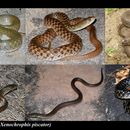en
names in breadcrumbs


The members of the Xenochrophis piscator group are among the most common snake species in the Oriental region, but have a long and confused taxonomic history. Vogel and David (2012) reviewed the complex taxonomic history of the genus Xenochrophis, with a focus on resolving relationships within the Xenochrophis piscator group, the members of which are clearly distinct from other Xenochrophis. Their taxonomic revision of the of Xenochrophis piscator species group was based on univariate analyses of external morphological characters of snakes from across the group’s geographic range (the authors state that complementary molecular phylogenetic analyses are planned). Vogel and David (2012) includes an extensive analysis of historical synonyms, with many photographs, and details what the authors recognize as valid taxa.
On a purely morphological basis, Vogel and David distinguish two informal groups of species:
The authors note that some taxonomic confusion remains, notably regarding X. piscator complex snakes occurring in India and Sri Lanka.
According to Vogel and David (2012), the genus Xenochrophis now includes the following 12 species: X. asperrimus (Boulenger, 1891), X. bellula (Stoliczka, 1871), X. cerasogaster (Cantor, 1839; type species of the genus Xenochrophis by monotypy), X. flavipunctatus (Hallowell, 1861), X. maculatus (Edeling, 1864), X. melanzostus(Gravenhorst, 1807), X. piscator (Schneider, 1799), X. punctulatus (Günther, 1858), X. schnurrenbergeri Kramer, 1977, X. tytleri (Blyth, 1863), X. trianguligerus (Boie, 1827), and X. vittatus (Linnaeus, 1758).
Vogel and David note that revisions of snake genera from the Oriental region in recent years have generally revealed considerable previously unrecognized diversity and that this pattern is likely to continue. They, further, suggest that revisions of widely distributed genera often cannot be carried out by native herpetologists by themselves because most of the preserved material (and older literature) is dispersed over collections in western countries, but that native workers have the advantage of conducting fieldwork more easily. Thus, general revisions such as Vogel and David (2012) can offer local herpetologists a framework for undertaking regional revisions based on fresh materials collected from selected localities.
(Vogel and David 2012 and references therein)
Vogel and Han-Yuen (2010) described an incidentsof death-feigning (or thanatosis) by Xenochrophis piscator, apparently only the second report of death-feigning by this species (this behavior was previously reported by MacDonal [1947] for snakes of this species confronted with a mongoose).
The checkered keelback (Fowlea piscator), also known commonly as the Asiatic water snake, is a common species in the subfamily Natricinae of the family Colubridae. The species is endemic to Asia. It is non-venomous.


The eye of F. piscator is rather small and shorter than its distance from the nostril in the adult. Its rostral scale is visible from above. The internasal scales are much narrowed anteriorly and subtriangular, with the anterior angle truncated and as long as the prefrontal scales. The frontal scale is longer than its distance from the end of the snout, and as long as the parietals or a little shorter. The loreal is nearly as long as it is deep. There are one preocular and three (rarely four) post-oculars. Its temporals are 2+2 or 2+3. There are normally nine upper labials, with the fourth and fifth entering the eye; and five lower labials in contact with the anterior chin-shields, which are shorter than the posterior. The dorsal scales are arranged in 19 rows, strongly keeled, with outer rows smooth. The ventrals number 125–158, the anal is divided, and the subcaudals number 64–90. Coloration is very variable, consisting of dark spots arranged quincuncially and often separated by a whitish network, or of black longitudinal bands on a pale ground, or of dark crossbands, with or without whitish spots. Two oblique black streaks, one below and the other behind the eye, are nearly constant. The lower parts are white, with or without black margins to the shields.[3]
The checkered keelback is a medium-sized snake, but may grow to be large. Adults may attain a snout-to-vent length (SVL) of 1.75 m (5.7 ft).[4]
Most of the time this snake tries to raise its head as much as possible and expand its neck skin mimicking a cobra hood and intimidate the threat. Though it is non-venomous to humans, it can deliver a painful bite which is inflammatory.
F. piscator may lose its tail as an escape mechanism. A rare case of such autotomy is reported from Vietnam.[5]
The preferred habitat of F. piscator is in or near freshwater lakes or rivers.

F. piscator feeds mainly on small fish and water frogs.
F. piscator is oviparous. Clutch size is usually 30-70 eggs, but may be as few as 4 or as many as 100. Egg size is also variable. Each egg may be 1.5–4.0 cm (0.59–1.57 in) long. The female guards the eggs until they hatch. Each hatchling is about 11 cm (4.3 in) long.[4]
F. piscator is found in Afghanistan, Bangladesh, Pakistan, Sri Lanka, India, Myanmar, Nepal, Thailand, Laos, Cambodia, Vietnam, West Malaysia, China (Zhejiang, Jiangxi, Fujian, Guangdong, Hainan, Guangxi, Yunnan), Taiwan, Australia and Indonesia (Sumatra, Java, Borneo, Celebes = Sulawesi)
type locality: "East Indies".
Nota bene: A trinomial authority in parentheses indicates that the subspecies was originally described in a genus other than Fowlea.
The subspecies F. p. melanzostus was raised to species status, as Fowlea melanzostus, by Indraneil Das in 1996.
{{cite journal}}: CS1 maint: multiple names: authors list (link) The checkered keelback (Fowlea piscator), also known commonly as the Asiatic water snake, is a common species in the subfamily Natricinae of the family Colubridae. The species is endemic to Asia. It is non-venomous.
 In Kerala
In Kerala  Checkered keelback with catfish kill, Kathmandu
Checkered keelback with catfish kill, Kathmandu